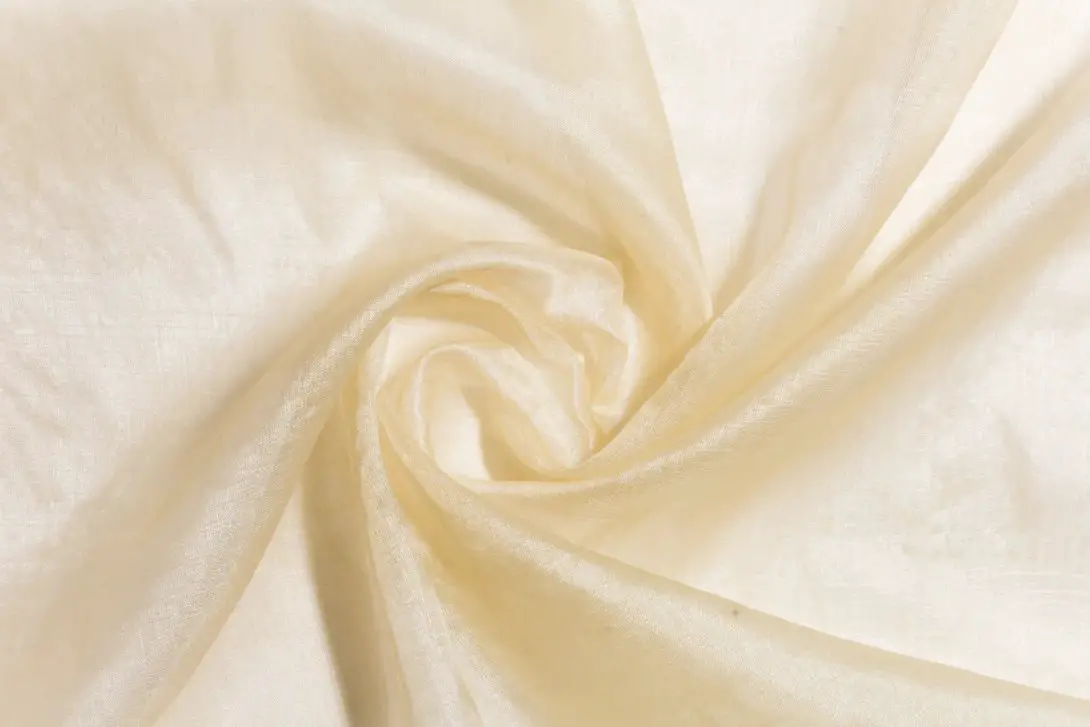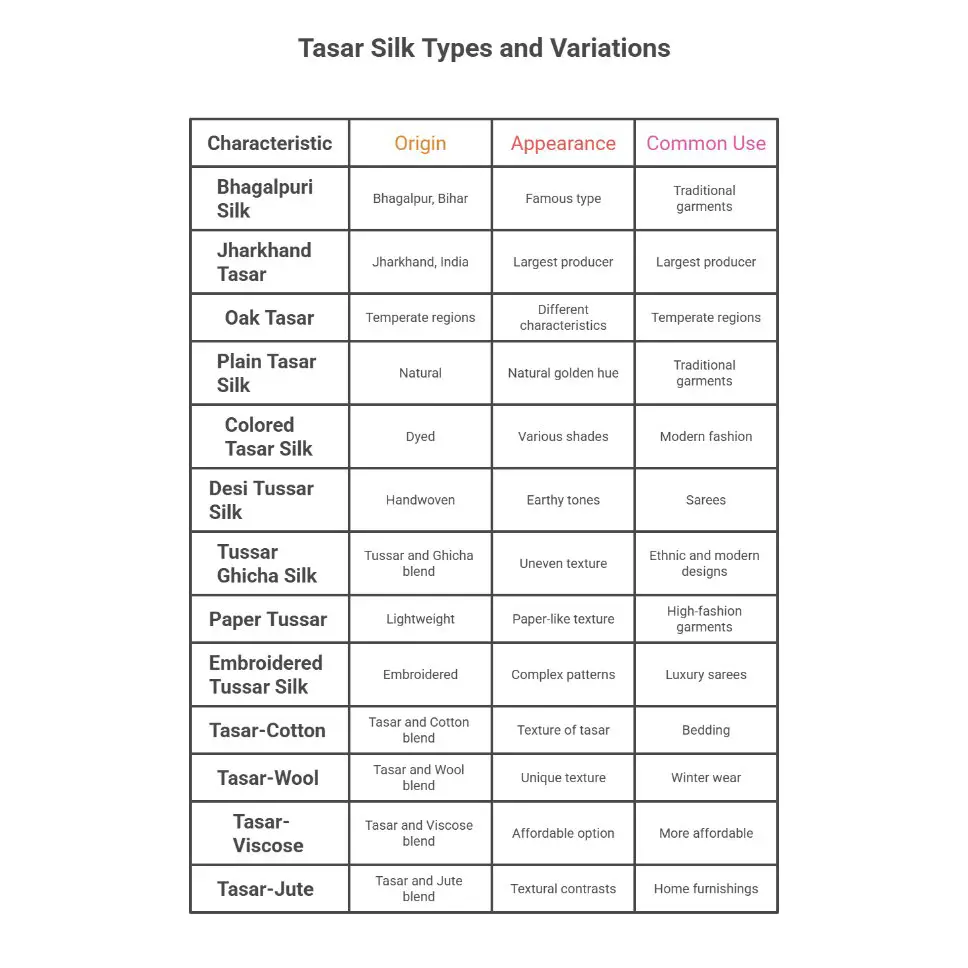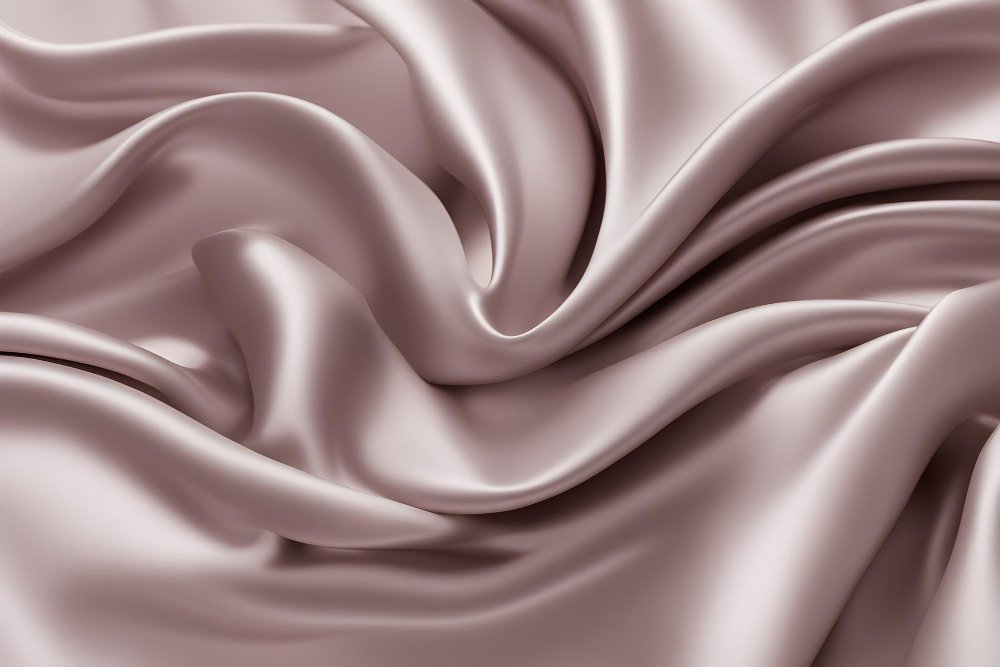Everything You Need to Know About Sustainable, Eco-Friendly Tasar Silk Fabric: Properties, Care, Uses, and More
Table of Contents
- What is Tasar Silk?
- History and Cultural Significance
- How Tasar Silk is Made
- Properties and Characteristics
- Sustainability and Ahimsa Silk
- Types and Variations
- Tasar vs. Mulberry Silk
- Uses and Applications
- How to Identify Authentic Tasar Silk
- Care Instructions
- Buying Guide and Pricing
- Major Production Regions
- Frequently Asked Questions
- Conclusion
What is Tasar Silk?

Tasar silk (also spelled tussar, tussah, tushar, or tassar) is a type of wild silk produced by silkworms that live freely in forest environments. Unlike the more common mulberry silk, which comes from domesticated silkworms raised on controlled farms, tasar silk is harvested from wild silkworms, primarily the Antheraea mylitta species, which feed on leaves of Arjun and Asan trees found in Indian forests.
The term “tasar” comes from the Sanskrit word “tasara,” meaning weaver’s shuttle, a reference found in ancient Vedic texts. This makes tasar silk one of the oldest known textile fibers, with a history spanning over 4,000 years. In some regions of India, it’s also called “Kosa silk” or “wild silk,” reflecting its natural origin and connection to forest ecosystems.
Quick Fact: Tasar silk is known for its natural golden to copper color, which comes from carotenoids present in the silk. This gives the fabric its signature warm, earthy tone without any artificial dyeing.
What makes tasar silk special is not just where it comes from, but its unique texture and properties. The fabric has a slightly coarse, textured feel compared to the smooth surface of regular silk. This distinct character comes from the wild silkworms’ diet and their natural habitat, which produces shorter but stronger silk fibers.

Natural tasar silk fabric showing its coarse texture and soft shimmer
History and Cultural Significance
The story of tasar silk is deeply connected to India’s tribal communities and forest ecosystems. Archaeological evidence suggests that tasar silk production dates back to the Indus Valley Civilization, making it one of the world’s oldest silk traditions.
Ancient Roots
While China pioneered mulberry silk production and kept it a closely guarded secret for centuries, India developed its own silk traditions using wild silkworms. The Sanskrit texts from ancient India mention various types of silk, with tasar being recognized as a premium material for its strength and natural beauty.
Tribal Heritage
Tasar silk production has been the traditional livelihood of tribal communities in central and eastern India for generations. The Koshti community from Maharashtra’s Bhandara district is particularly famous for their expertise in tasar silk weaving. For these communities, sericulture is more than just an economic activity – it’s a way of life that connects them to the forest and maintains their cultural identity.
The knowledge of identifying suitable trees, timing cocoon collection, and processing silk has been passed down through generations. Today, approximately 150,000 tribal farmers and artisans in India depend on tasar silk production for their livelihoods.
Cultural Note: In Indian tradition, every bride is expected to have at least one tasar silk saree in her trousseau. The fabric is considered auspicious and is commonly worn during religious ceremonies and special occasions.
How Tasar Silk is Made
The production of tasar silk is a natural process that works in harmony with forest ecosystems. Here’s how this beautiful fabric goes from wild silkworm to finished textile:
Wild silkworms feed on Arjun and Asan tree leaves
45-60 day life cycle until cocoon spinning
Cocoons gathered from forest trees
Cocoons boiled to extract silk fibers
8-10 cocoons reeled together into thread
Handloom weaving into fabric
The Silkworm Life Cycle
The tasar silkworm (Antheraea mylitta) has a complete life cycle of 45 to 60 days, depending on environmental conditions. Unlike domesticated silkworms, these wild varieties are hardier and more adapted to natural variations in temperature and food supply.
The silkworms feed continuously on leaves from their host trees – primarily Terminalia arjuna (Arjun) and Shorea robusta (Sal or Asan) trees. The diet of the silkworms directly affects the color and quality of the silk produced. Silkworms feeding on different trees produce slightly different shades, ranging from pale gold to deep copper brown.
Tropical vs. Temperate Tasar
There are two main varieties of tasar silk based on the climate where silkworms are reared:
- Tropical Tasar: Found in states like Jharkhand, Bihar, Chhattisgarh, Odisha, and Maharashtra. This is the most common type and accounts for the majority of India’s tasar silk production.
- Oak Tasar (Temperate Tasar): Cultivated in cooler regions like Manipur, Himachal Pradesh, Jammu and Kashmir, and Uttarakhand. Oak tasar silkworms feed on oak leaves and produce a slightly different quality of silk.
Processing and Weaving
After cocoons are collected, they undergo a process called degumming, where the natural protein coating (sericin) is removed. For tasar silk, this process requires special care because the silk is naturally brown due to tannin from the oak leaves. Modern eco-friendly methods use GOTS-approved degumming processes that minimize water usage and chemical treatment.
The reeling process for tasar silk typically involves combining 8-10 cocoons together to create a twisted thread of 40-50 denier. Because tasar silk fibers are shorter than mulberry silk fibers (which can reach up to 1,000 meters), multiple cocoons are needed to create a continuous thread strong enough for weaving. According to the Central Silk Board of India, the country’s apex body for silk development, tasar silk production employs over 150,000 farmers across various states.
Properties and Characteristics
Tasar silk has a unique set of properties that set it apart from other silk varieties and make it suitable for specific applications.
Natural Color
Golden to copper hues from natural carotenoids
Texture
Slightly coarse, textured with a distinctive weave
Luster
Matte to subtle sheen, not glossy
Breathability
Highly porous structure for excellent air flow
Strength
Stronger than mulberry silk, heat-resistant
Weight
Lightweight yet surprisingly strong
Physical Properties
The texture of tasar silk is often described as “rough” or “crinkly” with a characteristic checkerboard pattern in the weave. This is due to the shorter, thicker fibers that wild silkworms produce. When you run your fingers across tasar silk, you’ll feel a slightly grainy texture, quite different from the smooth, almost slippery feel of regular silk fabric.
Despite feeling coarse, tasar silk is soft to the touch and comfortable to wear. Many people compare its feel to cashmere or velvet. The fabric also produces a dull, crinkly sound when crumpled, unlike the crisp rustle of mulberry silk.
Breathability and Comfort
One of tasar silk’s standout features is its breathability. The fabric has a porous structure with ample spaces in the weave that allow constant air flow. This makes tasar silk more comfortable than many cotton varieties, especially in warm, humid climates.
The fabric also has excellent moisture-wicking properties and doesn’t retain water, which adds to its comfort factor. This quality makes it ideal for warm weather wear while also providing enough warmth for cooler seasons – a true all-season fabric.
Strength and Durability
Tasar silk is stronger and more durable than mulberry silk. While mulberry silk fibers are longer, tasar silk fibers are thicker and more resilient. The fabric can withstand higher temperatures and shows greater resistance to wear and tear over time.
This superior strength has led to some interesting applications. The medical equipment industry values tasar silk for its heat resistance and strength, using it in specialized surgical instruments and medicine delivery systems that require these specific properties.
Natural Color Variations
Tasar silk naturally comes in beautiful shades of gold, copper, brown, cream, and orange. The exact color depends on several factors:
- The specific diet of the silkworms (which trees they feed on)
- The climate and environmental conditions where they’re raised
- The processing methods used
These natural color variations mean that each piece of tasar silk fabric has its own unique character. Some people prefer to keep these natural shades, while others choose to dye the fabric to achieve specific colors.
Sustainability and Ahimsa Silk
In today’s fashion world, where sustainability matters more than ever, tasar silk stands out as an eco-friendly choice. But there’s an important conversation to have about exactly how sustainable and ethical tasar silk production can be.
What is Ahimsa Silk?
The term “Ahimsa” comes from Sanskrit, meaning non-violence. Ahimsa silk, also called peace silk, is produced without killing the silkworm. In traditional silk production, cocoons are boiled with the larvae still inside to extract long, continuous silk filaments. Ahimsa silk, however, allows the moth to emerge naturally from the cocoon before processing begins.
Tasar silk is often marketed as Ahimsa silk or peace silk, but it’s important to understand that not all tasar silk is produced this way. The decision to use non-violent methods is up to individual producers. Since there’s no legal requirement to produce silk humanely, you need to verify the production method if this matters to you.
Is Tasar Silk Ethically Sourced?
The answer is: it depends on the producer. Here’s what you should know:
Traditional Method
Cocoons are collected and boiled with the larvae inside to get long, continuous fibers. This is faster and produces more uniform silk, but the silkworms are killed in the process.
Ahimsa Method
Cocoons are left undisturbed for 7-10 days, allowing moths to emerge naturally. Each cocoon is checked individually before processing. This takes longer but preserves the silkworms’ lives.
However, even Ahimsa silk production has some controversies. Critics point out that some producers may underfeed silkworms or force them to hatch prematurely using fire, which can result in deformed moths that can’t fly and eventually die. This shows that “Ahimsa” certification alone doesn’t guarantee completely ethical treatment.
Environmental Benefits
Beyond the ethical treatment of silkworms, tasar silk offers several environmental advantages:
- Water Conservation: Tasar silk production uses approximately 1/4th the water needed for conventional silk. Modern regenerative farming methods with closed-loop water systems further reduce water consumption.
- Chemical-Free: Wild tasar silkworms don’t require pesticides or chemical fertilizers. They feed on naturally growing trees in forest environments.
- Biodiversity: Tasar sericulture supports forest ecosystems. The host trees (Arjun and Asan) provide habitat for various species and help prevent soil erosion.
- Carbon Footprint: Small-scale, tribal-based production means lower transportation emissions and traditional, low-tech processing methods.
- Forest Products: Since cocoons are collected from naturally growing trees, tasar silk is considered a forest product that supports sustainable forest management.
Regenerative Silk Farming
Some progressive producers are taking sustainability even further with regenerative agriculture practices. These farms focus on:
- Growing Arjun and Asan trees in converted organic soil
- Using natural compost instead of chemicals
- Implementing intercropping and rotational cropping
- Integrating animal husbandry to improve soil fertility
- Using GOTS-approved degumming methods
- Operating closed-loop water systems
These practices go beyond just being “sustainable” – they actually improve the environment and support both ecosystems and local communities.
Social Impact
Tasar silk production is primarily done by tribal communities in rural India. When produced ethically, it provides fair wages and year-round employment to marginalized populations. Many programs ensure that:
- Farmers receive fair prices for their cocoons without middlemen
- Workers are paid throughout the year, not just during harvest
- Communities maintain control over their traditional practices
- Women artisans gain economic independence through weaving
Supporting ethical tasar silk producers means supporting these communities and their traditional way of life.
Types and Variations
Not all tasar silk is the same. The fabric comes in several variations based on production methods, regional differences, and finishing techniques.

By Origin
- Bhagalpuri Silk: Produced in Bhagalpur and Banka districts of Bihar, this is one of the most famous types of tasar silk. The region has over 30,000 handloom weavers working on approximately 25,000 handlooms, with an annual trade value of around ₹100 crores.
- Jharkhand Tasar: Jharkhand is the largest producer of tasar silk in India, accounting for about 80% of the country’s total production. The state employs around 150,000 farmers in rearing, reeling, and weaving activities.
- Oak Tasar: Produced in temperate regions, this variation comes from silkworms feeding on oak leaves and has slightly different characteristics.
By Processing and Finish
- Plain Tasar Silk: Unbleached, natural color retained. This is the traditional form that shows off the fabric’s natural golden hue and earthy character. Preferred for traditional and high-end garments.
- Colored Tasar Silk: Dyed to achieve various shades and patterns. The fabric takes natural dyes beautifully while maintaining its characteristic texture. Popular in modern fashion and accessories.
- Desi Tussar Silk: Handwoven authentic fabric with natural golden sheen. Known for earthy tones and rustic appearance. Commonly used in sarees and traditional attire.
- Tussar Ghicha Silk: A unique blend of tussar and ghicha threads creating a beautiful, uneven texture. Lightweight and good for both ethnic and modern designs.
- Paper Tussar: Very lightweight and crisp with a paper-like texture. Gives a modern, structured look suitable for high-fashion garments with a matte finish.
- Embroidered Tussar Silk: Features complex patterns and designs on the fabric. Used for luxury traditional sarees and suits with varying levels of embroidery.
Blended Varieties
Tasar silk is often blended with other fibers to create unique textiles:
- Tasar-Cotton: Combines the texture of tasar with the comfort of cotton, often used for bedsheets and pillow covers.
- Tasar-Wool: Popular among knitters for its unique texture. Creates warm, luxurious fabrics perfect for winter wear.
- Tasar-Viscose: More affordable option that maintains some of the characteristics of pure tasar silk.
- Tasar-Jute: Creates interesting textural contrasts for home furnishings and artisanal products.
Tasar vs. Mulberry Silk: Key Differences
Many people wonder how tasar silk compares to the more commonly known mulberry silk. While both are beautiful and luxurious, they have distinct differences that make each suitable for different purposes.

| Feature | Tasar Silk | Mulberry Silk |
|---|---|---|
| Source | Wild silkworms (Antheraea mylitta) | Domesticated silkworms (Bombyx mori) |
| Diet | Arjun and Asan tree leaves | Exclusively mulberry leaves |
| Production | Wild/semi-wild forest collection | Controlled farm cultivation |
| Natural Color | Golden, copper, brown tones | Pure white to light yellow |
| Texture | Slightly coarse, textured | Smooth, uniform, silky |
| Luster | Matte to subtle sheen | High shine, glossy |
| Fiber Length | Shorter (300-400 meters) | Longer (up to 1,000 meters) |
| Strength | Stronger, more heat-resistant | Strong but less heat-resistant |
| Breathability | Highly breathable, porous | Less breathable |
| Durability | More durable for everyday use | Delicate, requires careful handling |
| Price Range | More affordable (₹3,000-4,000) | More expensive |
| Maintenance | Easier, less frequent cleaning | Requires more careful maintenance |
| Best For | Casual wear, embroidery, home décor | Formal wear, luxury bedding |
How Do They Stack Up?
Tasar silk beats mulberry silk in several important ways:
- Embroidery Work: Tasar silk’s texture and strength make it ideal for detailed embroidery with heavier threads. Mulberry silk can be challenging to embroider and may not hold up as well over time.
- Heat Resistance: Tasar silk can withstand higher temperatures, making it suitable for medical and industrial applications where mulberry silk would fail.
- Sustainability: Wild collection and forest-based production give tasar silk a lower environmental impact compared to intensive mulberry silk farming.
- Price: Tasar silk is more affordable, making luxury silk accessible to more people.
However, mulberry silk has its advantages too. If you want that ultra-smooth, glossy appearance for formal wear or luxury bedding, mulberry silk is the better choice. It’s also easier to dye in vibrant colors and produces that classic “silk” look that many people associate with luxury.
Want to compare different silk types side by side? Try our Fabric Comparison Tool to see how tasar silk stacks up against other popular silk varieties.
Other Silk Comparisons
Tasar silk is just one of several silk varieties produced in India. Here’s how it compares to other traditional silks:
- Eri Silk: Another type of wild silk, eri is the softest and warmest among all silks. It has a dense, woolly feel and is always produced as peace silk since the cocoons are open-ended.
- Muga Silk: Exclusive to Assam, muga silk is known for its natural golden color that never fades. It’s stronger than tasar silk and gets softer with each wash, but it’s also more expensive.
- Raw Silk: Unprocessed silk that retains its natural texture. Tasar silk is sometimes confused with raw silk, but they’re different – tasar refers to the silkworm species, while raw silk refers to the processing level.
Uses and Applications
Tasar silk’s unique properties make it suitable for a wide range of applications, from traditional clothing to modern fashion and even industrial uses.

Fashion and Apparel
The fashion industry loves tasar silk for its versatility and distinctive character:
- Traditional Wear: Sarees remain the most important tasar silk product. The fabric’s rich texture and natural sheen make it perfect for both everyday wear and special occasions. Tasar silk sarees are especially popular in eastern India.
- Modern Fashion: Designers use tasar silk for dresses, skirts, blouses, and jackets. The fabric’s textured appearance adds an ethnic twist to contemporary designs.
- Formal Wear: While less glossy than mulberry silk, tasar silk’s matte elegance makes it suitable for formal events, especially for those who prefer a more understated luxury.
- Casual Clothing: The breathability and durability of tasar silk make it comfortable for daily wear in warm climates.
- Accessories: Scarves, shawls, stoles, and handbags made from tasar silk are popular. The natural sheen and durability create elegant, long-lasting accessories.
Home Décor and Furnishings
Interior decorators appreciate tasar silk for adding warmth and elegance to living spaces:
- Curtains and Drapes: The fabric’s weight and texture create beautiful window treatments that filter light elegantly.
- Upholstery: Durable enough for furniture that gets moderate use. The textured surface hides wear better than smooth silks.
- Cushion Covers and Throws: Add a touch of luxury to sofas and beds. The fabric’s warmth makes it inviting.
- Table Linens: Tasar silk tablecloths and runners create an elegant dining atmosphere for special occasions.
- Wall Hangings: Used in traditional Indian pattachitra art from Odisha and kantha stitches from West Bengal.
Handicrafts and Artisanal Products
The fabric’s workability makes it popular for handcrafted items. Artisans use tasar silk for:
- Block printing and hand painting
- Kalamkari art (traditional Indian hand-painted textiles)
- Embroidery work
- Tie-dye techniques like bandhani and ikat
Industrial and Medical Applications
Beyond fashion, tasar silk has some surprising practical uses:
- Medical Equipment: The medical industry values tasar silk for its strength and heat resistance. It’s used in specialized surgical instruments and drug delivery systems that require these specific properties.
- Soap Making: This might surprise you, but tasar silk is a popular additive in luxury soaps. Short silk fibers are dissolved in lye water and added to oils. Soap made with tasar silk has a slippery, luxurious quality that makes it feel more premium than regular soap.
How to Identify Authentic Tasar Silk
With the market flooded with imitations and synthetic alternatives, knowing how to spot genuine tasar silk is important. Here are tried-and-tested methods to verify authenticity:

The Touch Test
Run your fingers gently across the fabric. Real tasar silk has a distinct, slightly coarse and grainy feel. It’s rougher than mulberry silk but still soft. If it feels too smooth or slippery, it might be mulberry silk or a synthetic imitation.
Visual Inspection
- Color: Look for natural golden, copper, brown, cream, or orange hues. Authentic tasar silk has a warm, earthy base color with subtle two-toned effects.
- Sheen: The luster should be muted and natural, not the brilliant shine of mulberry silk. Tasar silk has a soft, gentle shimmer.
- Texture: Check for the characteristic uneven texture and slight irregularities in the weave. These “imperfections” are actually hallmarks of authenticity.
- Weave Pattern: Genuine tasar silk often shows a checkerboard pattern in the weave due to thicker threads.
The Sound Test
Gently crumple the fabric near your ear. Real tasar silk produces a dull, crinkly sound, quite different from the crisp rustle of mulberry silk. Synthetic fabrics make a different sound altogether.
The Weight Test
Tasar silk is slightly heavier than mulberry silk of similar dimensions due to its coarser fibers. Hold the fabric – a slight heft compared to regular silk can indicate tasar.
The Burn Test
This is the most reliable test, though it requires burning a small thread from the fabric:
- Carefully extract a thread from an inconspicuous edge
- Hold it with tweezers and light it with a match
- Observe carefully:
Real Silk (Including Tasar)
- Burns slowly and curls away from flame
- Smells like burnt hair or burning feathers
- Leaves brittle, black ash that crumbles easily
- Flame goes out when removed from fire source
Synthetic/Artificial Silk
- Burns quickly and melts
- Smells like burning plastic or chemicals
- Leaves hard, plastic-like beads
- May continue burning after flame is removed
Check the Price
If the price seems too good to be true, it probably is. Genuine tasar silk is more expensive than synthetic alternatives, though more affordable than mulberry silk. As a rough guide, expect to pay ₹3,000-4,000 (approximately $35-50) for a pure tasar silk saree.
Ask for Certification
Reputable sellers should be able to provide:
- Silk Mark certification (a quality seal from the Silk Mark Organisation of India)
- Information about the production region
- Details about whether it’s Ahimsa silk
- Care instructions specific to tasar silk
Need Help? Try our Silk Identification Quiz to test your ability to spot authentic silk and learn more about different silk types.
Care Instructions: How to Wash and Maintain Tasar Silk
Proper care will keep your tasar silk looking beautiful for years. The good news? Tasar silk is easier to maintain than mulberry silk and requires less frequent cleaning.
Can Tasar Silk Be Washed?
Yes, tasar silk can be washed, but it requires gentle handling. You have two main options: hand washing at home or professional dry cleaning. For everyday items, hand washing is fine. For heavily embroidered pieces or special occasion wear, dry cleaning is safer.
How to Wash Tasar Silk at Home
-
Check for Colorfastness
Before washing the entire garment, test a hidden seam by dabbing it with a wet cotton swab or light-colored cloth. If color transfers to the cloth, the item needs professional dry cleaning.
-
Prepare the Washing Area
Fill a clean basin, sink, or bathtub with cold or lukewarm water. Never use hot water as it can damage silk fibers and cause shrinkage. Make sure you have enough water to completely submerge the garment comfortably.
-
Add Gentle Detergent
Use a mild detergent specifically designed for delicate fabrics or silk. Regular laundry detergent is too harsh. You can also use a gentle, pH-neutral shampoo (silk is protein-based, just like hair). Add just a few drops and mix well with your hand.
-
Soak Gently
Submerge your tasar silk item and let it soak for 3-7 minutes. Don’t leave it in water longer than necessary as silk becomes weak when wet. Gently swish the fabric through the water. Never scrub, wring, or twist the fabric.
-
Rinse Thoroughly
Drain the soapy water and refill with clean, cold water. Rinse the garment gently by moving it through the water. You may need to rinse 2-3 times to remove all detergent. Any soap residue left behind can damage the fabric or dull its appearance.
-
Remove Excess Water
Never wring or squeeze tasar silk. Instead, lay the wet garment flat on a clean, white towel. Roll the towel with the garment inside and gently press to absorb excess water. You can also use two towels and pat the garment between them.
-
Dry Properly
Hang the garment to air-dry or lay it flat on a clean towel away from direct sunlight. Never use a dryer or expose tasar silk to direct heat. Sunlight can fade colors and damage fibers. Choose a well-ventilated area out of direct sun.
Pro Tip: Want personalized care instructions based on your specific tasar silk item? Try our Silk Care Calculator for customized washing and maintenance recommendations.
Stain Removal Tips
For Oil or Grease Stains:
- Sprinkle talcum powder, cornstarch, or baking soda on the stain
- Test on a hidden area first and leave for 12 hours to confirm it’s safe
- If safe, apply to the stain and leave for 2-6 hours
- Gently brush off the powder
- Wash as usual if the stain is gone
For Deodorant Stains:
- Mix equal parts white vinegar and water
- Gently rub the solution with a clean cloth
- Rinse with cold water and air-dry
General Stain Advice:
- Always treat stains immediately – the longer they sit, the harder they are to remove
- Blot fresh stains with a clean, damp cloth (don’t rub)
- Never use commercial stain removers, which can damage the fabric
- For stubborn stains, take the garment to professional cleaners
Ironing Tasar Silk
- Always iron on the lowest heat setting or use the silk setting
- Turn the garment inside out before ironing
- Place a thin cotton cloth between the iron and the silk
- Never let the iron touch the silk directly
- Iron only when the fabric is completely dry or very slightly damp
- Avoid the steam setting, which can leave water spots
Storage Guidelines
- Store tasar silk in breathable muslin bags or cotton covers, never plastic bags (plastic traps moisture and can cause mildew)
- Hang garments or fold them carefully with embroidery on the inside
- Keep silk away from direct sunlight to prevent fading
- Use natural moth repellents like cedar blocks or neem leaves instead of mothballs
- Refold stored items every few months to prevent permanent creasing
- Add silica gel packets to absorb excess moisture
- Store in a cool, dry place with good air circulation
Special Care for Embroidered Tasar Silk
If your tasar silk has zari work, sequins, or embroidery:
- Always dry clean embroidered pieces – hand washing can damage the embellishments
- Store with embroidery facing inward to protect it
- Place tissue paper between folds to prevent embroidery from snagging
- Be extra careful when wearing jewelry – sharp edges can catch on threads
What NOT to Do
- Never machine wash (even on gentle cycle)
- Don’t use chlorine bleach or harsh chemicals
- Never wring or twist the fabric
- Don’t hang wet silk on wooden hangers (wood can stain)
- Avoid spraying perfumes or deodorants directly on silk
- Don’t store in plastic bags or airtight containers
Buying Guide: What to Look For and How Much to Pay

Why is Tasar Silk Expensive (But Still Affordable)?
Compared to synthetic fabrics, tasar silk is expensive because:
- Production is labor-intensive and time-consuming
- Wild collection requires skilled workers who know forest ecosystems
- Processing and weaving are mostly done by hand
- The quality and uniqueness command premium prices
However, tasar silk is more affordable than mulberry silk because:
- Wild silkworms require less intensive care than domesticated ones
- No need for controlled farm environments
- Shorter fibers mean less processing time
- It’s less lustrous, making it less sought-after for formal luxury wear
Price Ranges
Here’s what you can expect to pay for authentic tasar silk products:
| Product | Price Range (INR) | Price Range (USD) |
|---|---|---|
| Plain Tasar Silk Saree | ₹3,000 – ₹6,000 | $35 – $70 |
| Embroidered Tasar Silk Saree | ₹6,000 – ₹15,000+ | $70 – $180+ |
| Tasar Silk Fabric (per meter) | ₹500 – ₹1,500 | $6 – $18 |
| Tasar Silk Stole/Scarf | ₹1,000 – ₹3,000 | $12 – $35 |
| Tasar Silk Curtains (per panel) | ₹2,000 – ₹5,000 | $25 – $60 |
Prices vary based on:
- Quality of silk
- Weaving technique (handloom is more expensive)
- Embroidery or embellishments
- Region of origin (Bhagalpuri silk commands premium prices)
- Whether it’s Ahimsa/peace silk
- Brand or artisan reputation
Where to Buy
- Government Emporiums: State-run stores like Tantuja (West Bengal) and Purbasha (Jharkhand) sell authentic tasar silk at fair prices
- Handloom Exhibitions: Government-organized fairs where you can buy directly from weavers
- Artisan Cooperatives: Support tribal communities by buying from fair-trade cooperatives
- Trusted Online Retailers: Look for sellers with Silk Mark certification and good reviews
Can Tasar Silk Be Dyed?
Yes, tasar silk can be dyed, though the natural color provides a beautiful base that many prefer to keep. The fabric takes natural dyes beautifully, and the resulting colors have depth and character. However:
- The natural golden/copper undertone affects the final color
- Light colors may show the base color through
- Dark, rich colors work best and create stunning results
- Natural dyes are preferred for maintaining the eco-friendly nature of the fabric
Questions to Ask Sellers
- Is this 100% tasar silk or a blend?
- Where was it produced?
- Is it handloom or power loom?
- Is it Ahimsa/peace silk?
- Does it have Silk Mark certification?
- What are the specific care requirements?
- Can I see documentation or certificates?
Major Production Regions in India
India is the world’s second-largest producer of tasar silk and the exclusive producer of tropical tasar silk. Here’s where the magic happens:

Which State is Famous for Tasar Silk?
Jharkhand
Jharkhand is the undisputed leader in tasar silk production, accounting for approximately 80% of India’s total output. The state employs around 150,000 tribal farmers and artisans in sericulture activities. The Kharsawan district is particularly famous for its skilled tribal weavers who have passed down their craft through generations. A beautiful 10-meter silk saree can take 3-4 days of skilled work to complete.
Bihar
The Bhagalpur and Banka districts of Bihar are famous for “Bhagalpuri silk,” which has become synonymous with quality tasar silk. The region has a silk-weaving tradition over a century old, with about 30,000 handloom weavers working on approximately 25,000 handlooms. The annual trade value is around ₹100 crores, with about half coming from exports.
Chhattisgarh
Chhattisgarh produces significant quantities of tasar silk and is known for supporting tribal sericulture. The state has abundant Sal and Arjun trees, providing ideal conditions for wild silkworms.
Odisha
Odisha’s tasar silk is used extensively in the state’s famous pattachitra art – traditional scroll paintings on cloth. The state also produces quality tasar silk sarees that are popular across India.
West Bengal
The Malda district of West Bengal is known for tasar silk production. The silk is also used as a base for Bengal’s traditional kantha stitch embroidery due to its affordable price compared to mulberry silk.
Maharashtra
The traditional home of the Koshti community, Maharashtra has a long history with tasar silk. The Bhandara district is particularly significant in the fabric’s cultural heritage.
Temperate Region States
Manipur, Himachal Pradesh, Jammu and Kashmir, and Uttarakhand produce oak tasar silk, a temperate variety where silkworms feed on oak leaves in cooler climates.
India vs. Other Countries
While India is the second-largest producer globally, China remains the world’s largest tasar silk producer. Other countries producing tasar silk include:
- Japan (primarily Antheraea yamamai)
- Sri Lanka
- Parts of East Asia
However, India is the only country producing all four varieties of commercial silk (mulberry, tasar, eri, and muga), making its silk industry uniquely diverse.
Frequently Asked Questions
Conclusion
After learning everything about tasar silk, it’s clear why this fabric has survived for over 4,000 years and continues to win hearts today. It’s not just another type of silk – it’s a unique textile that balances luxury with practicality, tradition with sustainability, and beauty with durability.
Key Takeaways
Unique Character
Tasar silk’s textured surface, natural golden color, and matte finish make it stand out from other silks. It brings an earthy elegance that smooth, glossy silks can’t match.
Superior Practicality
Stronger than mulberry silk, more breathable than most fabrics, and easier to maintain – tasar silk works hard for you while looking luxurious.
Eco-Friendly Choice
Wild collection, forest-based production, minimal water usage, and the option for Ahimsa silk make tasar one of the most sustainable luxury fabrics available.
Cultural Heritage
Supporting tasar silk means supporting tribal communities who have preserved this craft for generations, maintaining their connection to forest ecosystems.
Great Value
More affordable than mulberry silk while offering unique benefits, tasar silk makes luxury accessible without compromising on quality or ethics.
Versatile Applications
From traditional sarees to modern fashion, home décor to industrial uses, tasar silk adapts to countless applications while maintaining its distinctive character.
Making the Right Choice
When shopping for tasar silk, remember these recommendations:
- Always verify authenticity using the tests we’ve covered – touch, sight, sound, and if possible, the burn test
- Look for Silk Mark certification to ensure you’re getting genuine Indian silk
- Consider Ahimsa silk if ethical production is important to you, but verify the producer’s practices
- Buy from reputable sources – government emporiums, certified cooperatives, or trusted retailers
- Don’t be fooled by suspiciously low prices – authentic tasar silk has a cost that reflects its production process
- Ask questions about origin, production methods, and care requirements
Caring for Your Investment
With proper care, tasar silk pieces can last for decades and even become family heirlooms. The fabric actually requires less maintenance than you might think – just gentle handling, cold water washing, no harsh chemicals, and smart storage. The small effort you put into caring for tasar silk pays off in longevity and continued beauty.
Supporting Sustainability and Communities
Every purchase of authentic tasar silk supports:
- Tribal communities in rural India who depend on sericulture
- Forest ecosystems that provide habitat for wild silkworms
- Traditional crafts and handloom weaving techniques
- Sustainable, low-impact textile production
- Fair wages for artisans and farmers
The Bottom Line
Tasar silk isn’t trying to be mulberry silk, and that’s exactly what makes it special. If you want that ultra-smooth, glossy luxury for formal occasions, stick with mulberry silk. But if you appreciate natural texture, earthy elegance, practical durability, and sustainable production, tasar silk is your fabric.
It’s perfect for those who want luxury with a conscience, tradition with comfort, and beauty that doesn’t demand perfection. Whether you’re adding a tasar silk saree to your wardrobe, choosing curtains for your home, or looking for a versatile fabric for your next sewing project, tasar silk offers something truly special – a piece of India’s ancient textile heritage that’s more relevant today than ever.
Ready to Explore More? Check out our comprehensive Guide to Silk Fabric to learn about other silk varieties, or visit our Silk Care Guide for detailed maintenance tips for all silk types.
The world of tasar silk is rich, sustainable, and full of beautiful possibilities. Now that you know everything about it, you’re ready to make informed choices and appreciate this wonderful fabric for all it offers.
Additional Resources
For more information about tasar silk and silk production in India, visit these authoritative sources:
- Wikipedia: Tussar Silk – Comprehensive encyclopedia entry on tasar silk
- Silk Mark Organisation of India – Official certification body for genuine silk products
- Central Silk Board of India – Government authority on sericulture and silk production


